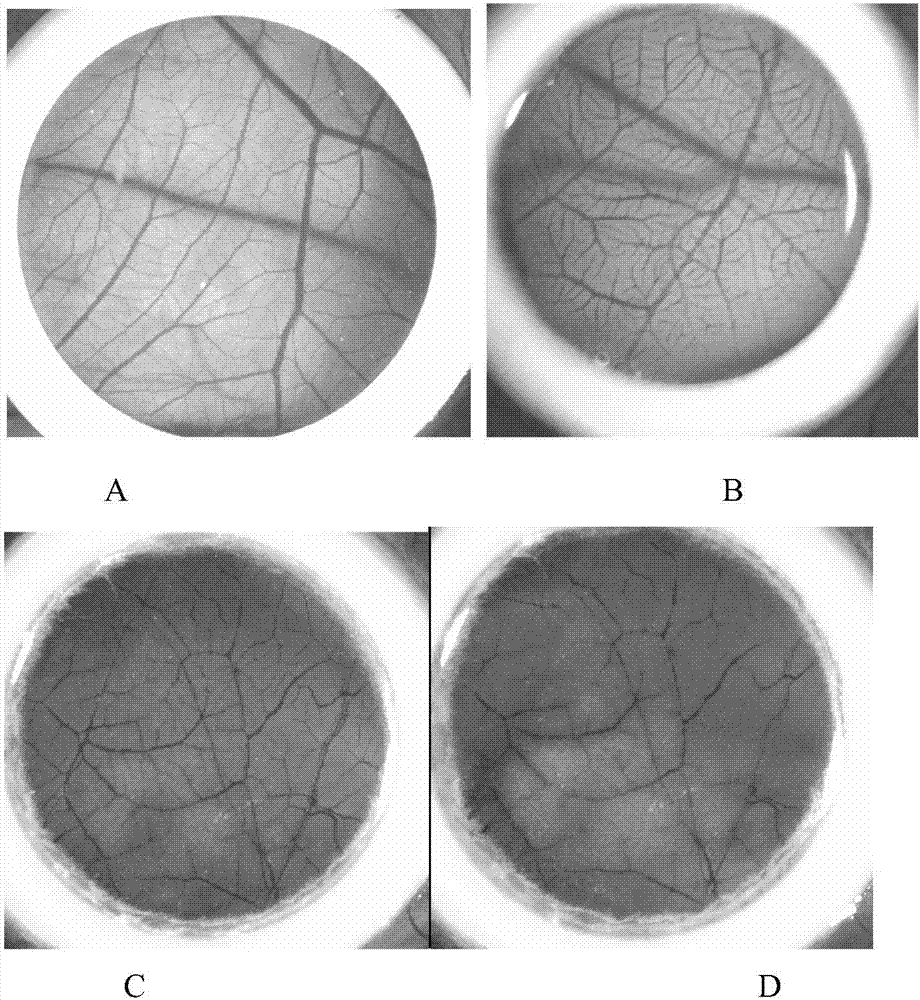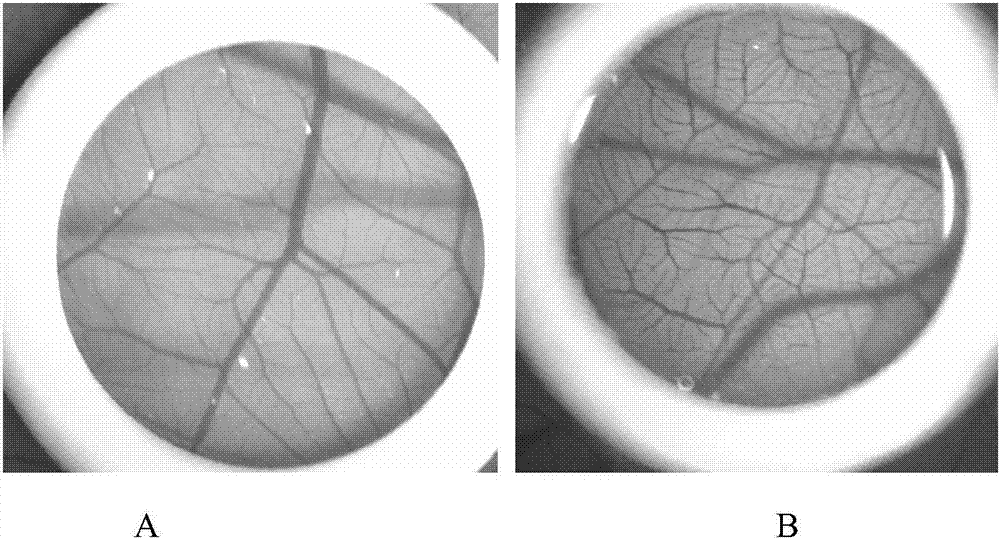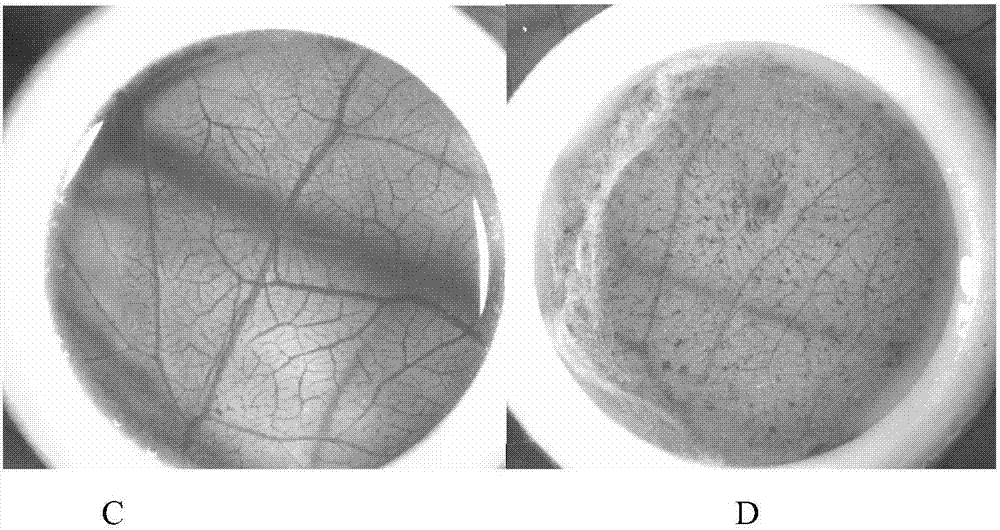Method for detecting and evaluating conjunctiva irritation and mucous membrane irritation by utilizing chick embryo blood vascular system
A vascular system and irritation technology, which is applied in the field of detection and evaluation of conjunctival irritation and mucous membrane irritation by using chicken embryo vascular system, can solve problems such as insoluble, high cost, and health hazards of volunteers, and achieve a high degree of standardization The system is simple and the detection method is fast
- Summary
- Abstract
- Description
- Claims
- Application Information
AI Technical Summary
Problems solved by technology
Method used
Image
Examples
Embodiment 1
[0152] Embodiment 1 utilizes chicken embryo vasculature to detect and evaluate the method for sulfacetamide sodium conjunctival irritation
[0153] 1. Preparation of natural chorioallantoic membrane
[0154] Purchase 7d-year-old chicken embryos, store them in egg racks with the air chamber facing up, and transfer them to the laboratory, inspect them as eggs, and discard inactive and defective chicken embryos. The chicken embryos are incubated at an incubation temperature of 37.5°C±0.5°C and a relative humidity of 60%-70% until they are 10 days old. At the age of 10 days, check the chicken embryo according to the egg, mark the position of the air cell on the surface of the eggshell; peel off the eggshell part with dental serrated curved tweezers, expose the white egg film, add 1-2mL of 0.9% NaCl solution to make the egg film wet, and then The solution was decanted and the inner membrane was carefully removed with forceps, exposing the native chorioallantoic membrane.
[0155]...
Embodiment 2
[0170] Example 2 The method for detecting and evaluating eye cream conjunctival irritation by using chicken embryo vascular system
[0171] 1. Preparation of artificial chorioallantoic membrane
[0172] The purchased SPF grade fertilized chicken embryos with an embryonic age of 0 days were incubated in a constant temperature incubator with a temperature of 37°C ± 1°C and a relative humidity of 65% ± 5%. On day 3, place the embryos horizontally. On the 4th day, check the chicken embryos against the light, and discard the chicken embryos that are not fertilized or underdeveloped. For normally developing chicken embryos, a small hole is opened from the non-air cell side of the egg, the dust is wiped off with an alcohol cotton ball, and 2.5-3mL egg white is drawn out from the small hole with a syringe to form an artificial chorioallantoic membrane. The pores were sealed with paraffin. Then open a small rectangular window with a side length of 0.8-1 cm above the top of the egg. ...
Embodiment 3
[0187] Example 3 Method for detecting and evaluating the conjunctival irritation of shampoo using chicken embryo vasculature
[0188] 1. Preparation of artificial chorioallantoic membrane
[0189] The purchased SPF grade fertilized chicken embryos with an embryonic age of 0 days were incubated in a constant temperature incubator with a temperature of 37°C ± 1°C and a relative humidity of 65% ± 5%. On day 3, place the embryos horizontally. On the 4th day, check the chicken embryos against the light, and discard the chicken embryos that are not fertilized or underdeveloped. For normally developing chicken embryos, a small hole is opened from the non-air cell side of the egg, the dust is wiped off with an alcohol cotton ball, and 2.5-3mL egg white is drawn out from the small hole with a syringe to form an artificial chorioallantoic membrane. The pores were sealed with paraffin. Then open a small rectangular window with a side length of 0.8-1 cm above the top of the egg. The sma...
PUM
 Login to View More
Login to View More Abstract
Description
Claims
Application Information
 Login to View More
Login to View More - R&D
- Intellectual Property
- Life Sciences
- Materials
- Tech Scout
- Unparalleled Data Quality
- Higher Quality Content
- 60% Fewer Hallucinations
Browse by: Latest US Patents, China's latest patents, Technical Efficacy Thesaurus, Application Domain, Technology Topic, Popular Technical Reports.
© 2025 PatSnap. All rights reserved.Legal|Privacy policy|Modern Slavery Act Transparency Statement|Sitemap|About US| Contact US: help@patsnap.com



